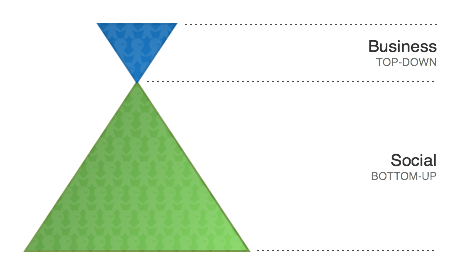Any good social business is built on two carefully balanced pyramids, which mirror two different approaches that are required to coexist in a business that wants to thrive in a world where its customers are highly connected.

The first pyramid is the business as it’s usually intended. It is built top-down, where decisions and strategies are defined at the top level and propagated downward toward a single carefully crafted communication channel, which might even span or multiple media, but still fundamentally ‘broadcast’ in nature.
This kind of approach usually takes its driving force from both the company values and its market strategy, building on them and trying to find the correct way to communicate to an audience.
The second pyramid is the business as perceived and lived by its customers, by the people using its services, and it is by nature bottom-up. It is also bigger, of course, and made up by a complex network of discussions, relationships and interactions with the brand itself. This second pyramid is going to exist regardless of any action in this direction from the business itself, because it’s a natural evolution of the interactions between people.
This very simple metaphor means two very important things:
- The ownership of the social element in a business is a coordination between the top pyramid and the bottom pyramid – one cannot exist without the other. Trying to take complete ownership of that often translates into an alienated audience, while at the same time complete carelessness can lead to blunt surprises when the complex social interactions emerge in a more unified response.
- The balancing of the top pyramid, the business itself, is simpler if you allow it to “merge” it with the bottom pyramid by engaging the workforce. This means for the business to engage more with its users, allowing the internal people to interact with the external people, as human beings and not behind the company-controlled wall. This process creates an ecosystem with permeable boundaries that translates directly to more permeability, stability and feedback to improve the business itself.
There are various strategies to surface this double pyramid and allow the two pyramids to begin to merge. While the strategy itself may vary a lot between businesses, there are two core elements:
- The person the business wants to talk and interact with needs to be understood in terms of values and motivations. Failure to understand them leads to a negative ROI, while a correct understanding amplifies the good signals and creates value for both the person and the business.
- The ecosystem is a complex adaptive system. Complex systems can’t be built, but can be evolved through good social experience design that is able to pick the correct signals and amplify them in the direction that is better for both the person and the company.
An excellent example of this is the Vodafone Lab community, created in July 2008, as an open space to test and get feedback from users and developers on new and innovative solutions coming out of Vodafone’s tech team.
Developers are a core component in these kinds of community, and they are usually driven by a slightly different set of values. They are often highly curious individuals, trying to find optimal solutions for a problem, and they aspire to be recognised for their skills. Money and prizes here are not major motivators, but challenges and responses are very valuable.
Vodafone started creating a very small service, engaging a few people and then constantly evolved its wiki, forum and blog services in order to adapt to the needs that the users were expressing, supporting them with a constant and transparent feedback. Over the years, more and more features were added, but never more than the users required, and today the site supports them with technology news and informative videos as well.
At the beginning of 2011, the site reached more than 200,000 registered users, with a really high level satisfaction, which comes across clearly in the forums and answers, with people apparently happy to help solve problems and provide hints, creating value for both themselves and Vodafone.
This is a good example of a community that evolved its double pyramid, understanding people and designing ‘nudges’ that helped the community to take shape, and integrated the top-down pyramid with the bottom-up one in a seamless social layer.